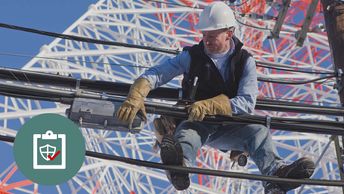Electrical Hazards: Shock, Electrocution, Arc Flash and Arc Blast (2021 Edition)
- 18 topics | 1h 24m
- Up to 30 languages
- Transcripts
This course provides a comprehensive overview of the basic criteria for electrical safety-related work practices stipulated in the National Fire Protection Agency (NFPA) 70E Standard for Electrical Safety in the Workplace. It presents detailed information on the practices, programs, techniques, and processes related to electrical work, in accordance with the NFPA Standard. This course was developed with subject matter support provided by EnSafe Inc., a global professional services company focusing on engineering, environment, health and safety, and information technology. Please note, the course materials and content were current with the laws and regulations at the time of the last expert review, however, they may not reflect the most current legal developments. Nothing herein, or in the course materials, shall be construed as professional advice as to any particular situation with respect to compliance with legal statutes or requirements.
WHAT YOU WILL LEARN
-
identify safety responsibilities that are specific to employers
-
identify employees' safety responsibilities
-
identify the three primary requirements in multi-employer relationships
-
identify the NFPA 70E training requirements for qualified workers
-
identify the NFPA 70E training requirements for unqualified workers
-
match topics of the NFPA 70E standard with the chapters in which they can be found
-
identify examples of electrical hazards that NFPA 70E seeks to protect against
-
identify examples of the eight steps used to establish and verify electrical equipment is in an electrically safe work condition
-
identify the safety procedures observed by employees involved in the lockout/tagout process
-
identify situations where one qualified person should have full responsibility for the lockout/tagout procedure
-
identify conditions under which it is safe to re-energize equipment and return it to service
-
identify hazards associated with working within the limited approach boundary of energized electrical conductors or circuit parts
-
identify what is determined in a shock risk assessment
-
identify what is determined in an arc flash risk assessment
-
identify the three alerting techniques to warn employees about electrical hazards
-
match descriptions of protective clothing to their corresponding arc flash PPE categories as specified in NFPA 70E
-
identify guidelines on the use of CPR with a shock victim
-
identify examples of the correct steps followed to rescue a shock victim
IN THIS COURSE
-
Identifying Employers' Safety Responsibilities4m
-
Recognizing the Employees' Role in Promoting Safety2m
-
Meeting Multi-employer Requirements3m
-
Following NFPA 70E Training Requirements5m
-
Providing Training for Unqualified Workers3m
-
Reviewing the NFPA 70E Standard4m
-
Identifying Types of Electrical Hazards6m
-
Establishing an Electrically Safe Work Condition8m
-
Recognizing Lockout/Tagout Safety Procedures4m
-
Following Lockout/Tagout Protocols5m
-
Staying Safe When Re-energizing Equipment3m
-
Identifying Limited Approach Boundary Hazards4m
-
Conducting Shock Risk Assessments3m
-
Performing an Arc Flash Risk Assessment2m
-
Warning Employees about Electrical Hazards5m
-
Identifying Arc Flash PPE Categories6m
-
Providing CPR to a Shock Victim3m
-
Rescuing a Shock Victim4m
YOU MIGHT ALSO LIKE
COMPLIANCE-COURSE
Spill Response and Control Impact: Responsibilities During a Spill
COMPLIANCE-COURSE
Electrical Safety: Qualified Worker – Part 1
COMPLIANCE-COURSE
Pedestrian Safety 2.0


